As the La Liga campaign began, Real Sociedad, under the fifth year of Imanol Alguacil’s management, did not enjoy the start they would’ve wished for, with only one win in the first five games.
One
reason is that the team has to adapt to David Silva’s retirement and play slightly differently after the former Man City midfielder suffereda severe knee injury and was forced to stop playing football.
With the summer additions and the development of their own players, Sociedad has entered a new era with other ways to attack.
This tactical analysis will explain how Imanol Alguacil’s tactics and the team are evolving from using Silva as a vital part of the team to their new shift of offensive focus and tactics.
How Real Sociedad used to play with David Silva
Some coaches believe formations are just numbers, but in the context of Sociedad, they still indicate what they want as a team.
However, the outcome could vary because of different individual qualities.
This team sheet was Imanol Alguacil’s Sociedad’s starting lineup versus Roma in the UEFA Europa League:
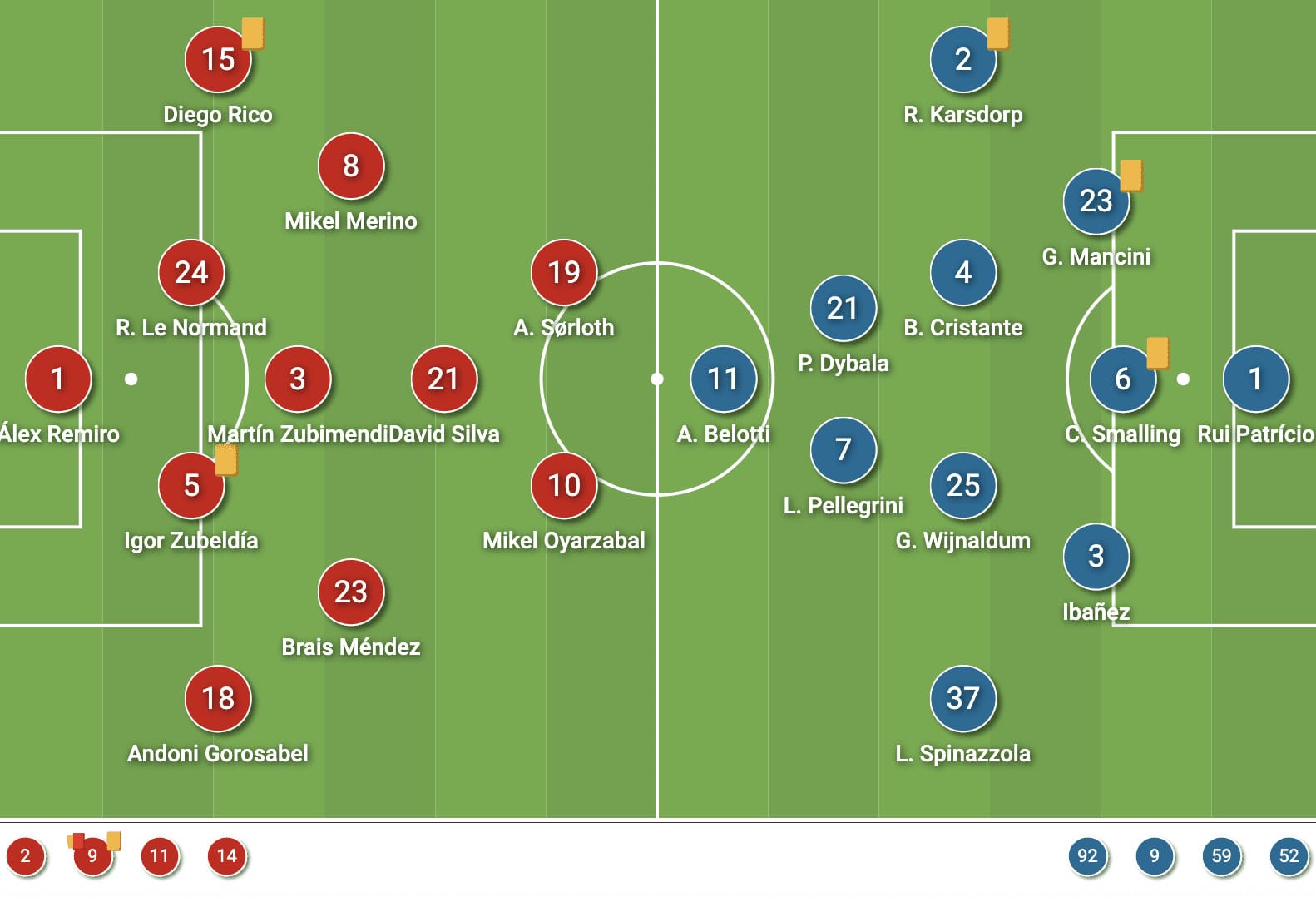
Alguacil preferred a 4-D-2 formation in the 2022/23 season when they had Alexander Sørloth as the striker, partnering Mikel Oyarzabal and Take Kubo.
This also allowed Silva to start behind the striker, playing in spaces between the lines more in a match while keeping all of their excellent midfielders—Mikel Merino, Martín Zubimendi, and Brais Méndez—on the field.
With Silva available, La Real always played with this formation.
Below, we are into more game examples of how they use the 4-D-2 formation to drive the team and create offensive chances in the final third.
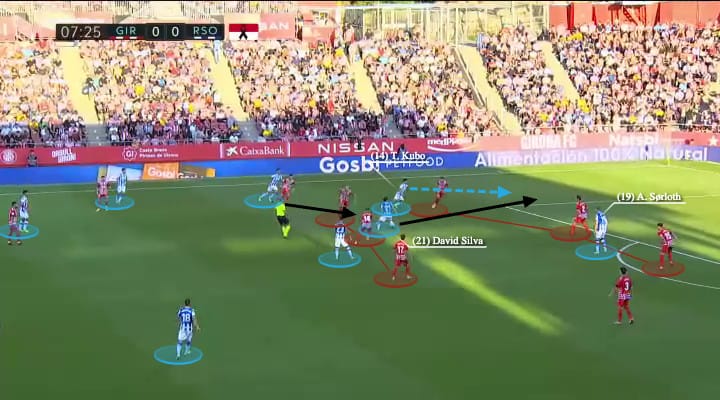
Even though, on paper, there were two Sociedad strikers, they were not fixed in a position or given a closed role, such as pinning the central defenders.
Only Sørloth is the conventional striker who stays central more often, and his partner usually enjoys more roles, such as roaming or making runs to create conditions to break lines.
In the Girona example, the striker-pair was Sørloth and Kubo, but the Japanese international moved outside.
It was a clever detail to fit the characteristics of the players, as Kubo was a wide attacker with fair dribbling, while the formation lacked wide players to attack the flank.
It became very natural for one of their strikers to go outside and make movement behind.
This is where Silva contributed a lot; he was extremely good at tearing the defence with passes, so he could always release the runner in spaces between lines.
Also, the flank had greater cohesion, as Silva would help the team move together to allow better reactions in transitions.
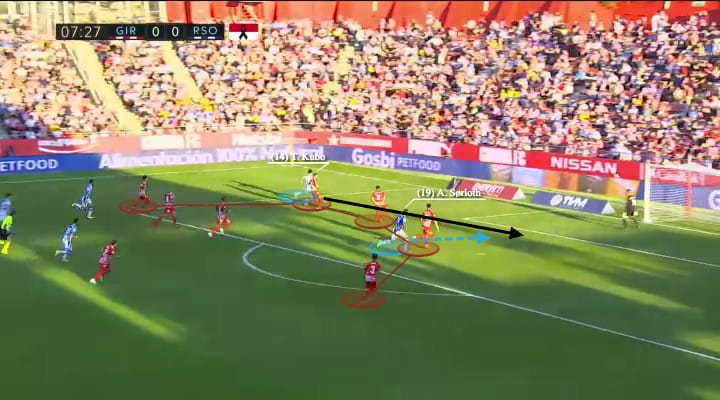
As Kubo went down the line, we could see the goalscoring formula of Sociedad in the second image.
In this case, the remaining striker, Sørloth, would be ready to arrive into the centre or the far post to convert the chance when the cross came in.
Especially against an opponent with a back five, this central option could exploit space behind the wing-back or stay on the blindside of the central defender (who has to see the ball) to finish the action.
Also, when Sociedad broke the last line, to a large extent, they had to hope for the early movements of strikers behind the defence, which led to disruption and opened the gaps.
This goal versus Mallorca was another example.
The opponent also played with a back five.
Carlos Fernández and Oyarzabal were the strikers.
When Méndez had the ball, Fernández made an early run behind and brought the central defender (Antonio Rafflo) with him to open a gap between red shirts.
Oyarzabal could exploit 1v1 situations, but Silva could also attack in this kind of situation.
Physically, maybe he was slow, but he had great awareness of the situation, so he timed the run well.
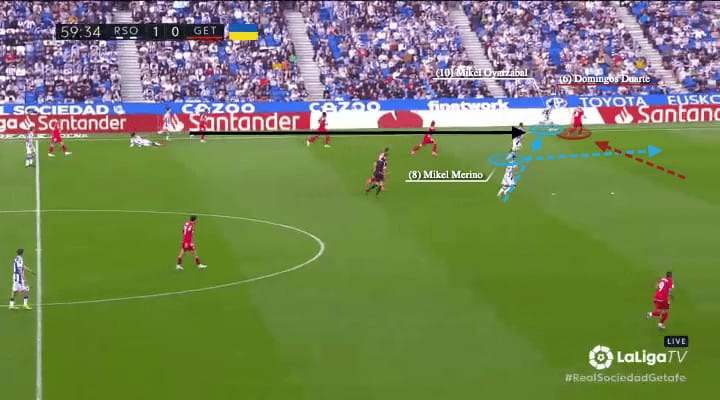
Silva was not the only one who benefited from the early runs; other midfielders, such as Méndez and Merino, also had to make many movements behind when there were gaps because the main objective was to fix the defence’s attention on the side, go down the line, and find the free striker who finishes in a good position.
This example versus Getafe shows Oyarzabal making an early run to the side and stretching the defence, opening a gap for Merino to run into.
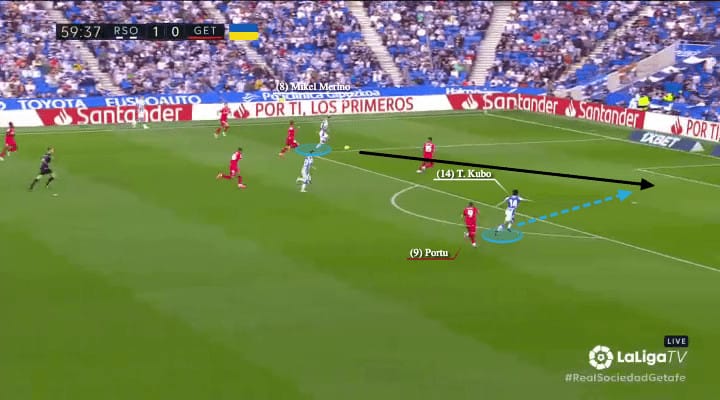
As Merino received behind the defence, Kubo was there as the other striker.
And again, he took advantage of Portu, who was the left wing-back of Getafe.
However, this attacking pattern mostly happened on the left flank because Sociedad had more left-footed players who could make runs and cross early on before the box was closed.
On the right side, they still had run, but it was less natural for Silva and Méndez to cross in the first time.
Transfers in the summer window
Before going into the next part to explain how Alguacil changed his tactics in the new season, we must define the club’s transfer activities to understand the squad better.
As mentioned, Silva retired.
Asier Illaramendi joined MLS side FC Dallas as a free player, and the club could not afford to purchase Sørloth from RB Leipzig.
The main focus was wide defenders as they signed Kieran Tierney and Hamari Traoré to replace Andoni Gorosabel, Álex Sola, and Diego Rico.
They also loaned André Silva from Leipzig and signed Arsen Zakharyan, but neither has played for the team yet; the Portuguese striker had a hamstring injury, while the latter mainly was starting on the bench.
A new era in the 2023/24 season
A stark contrast to last season with Silva is the formation.
Alguacil tried a 4-1-4-1 when Silva was absent last season, but now the team’s primary formation is the 4-1-2-3.
Sociedad has become more direct, trying to capture the space behind opponents before it is closed.
They also generated more attacks from the flanks; we will explain more in this scout report.
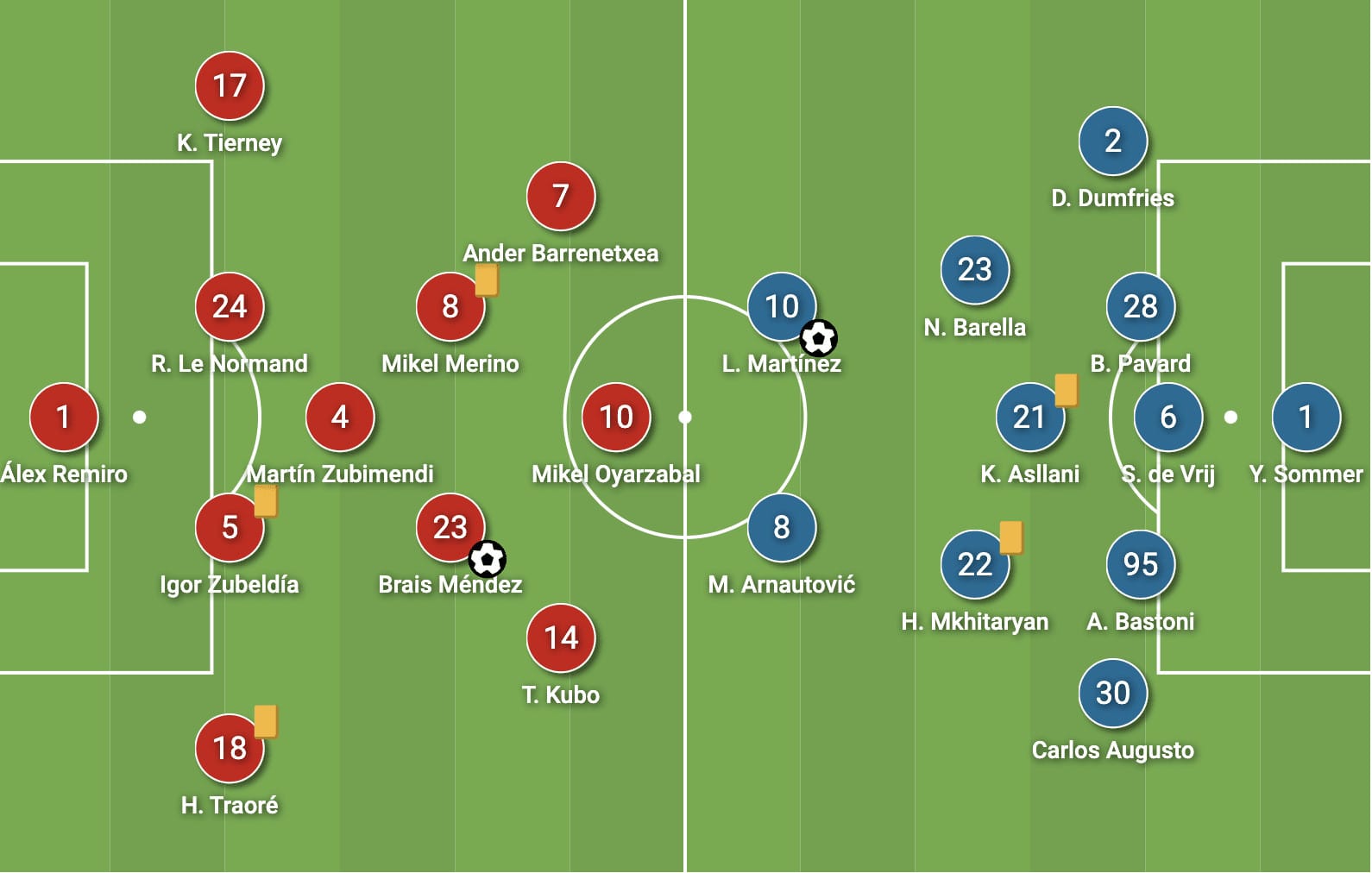
This was Sociedad’s starting XI versus Inter in the UEFA Champions League.
The formation has changed.
The crucial part in midfield — Merino, Méndez, Zubimendi was the same.
Both new full-backs started in the defence.
They no longer keep a number 10 in the front three like Silva, who played between the lines, probably because it was too difficult to replace his quality.
Instead, Oyarzabal or Fernández started as a striker, with Ander Barrenetxea on the flanks.
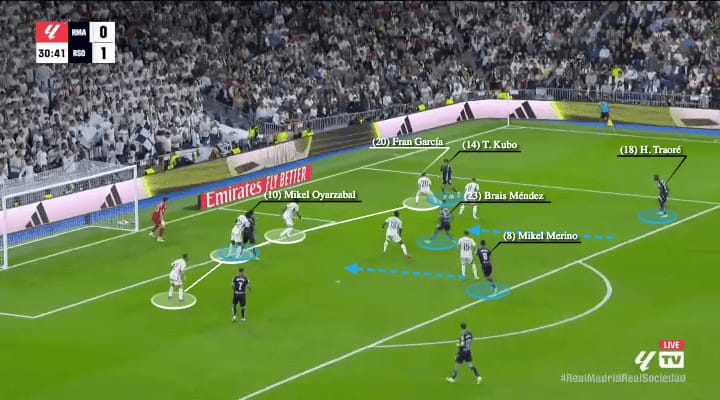
To a large extent, Sociedad’s attacks were created from the flanks, as they had better qualities in full-backs. This was also thanks to Kubo, who returned to a “proper winger” position and allowed him to thrive on the flanks.
Now, Kubo enjoys taking on opponents and carrying the ball forward, making good deliveries into the box, or taking shots to test the goalkeeper.
Also, Méndez and Merino made more runs to attack the penalty box, arriving from deep and taking dynamic advantage in the finishing actions.
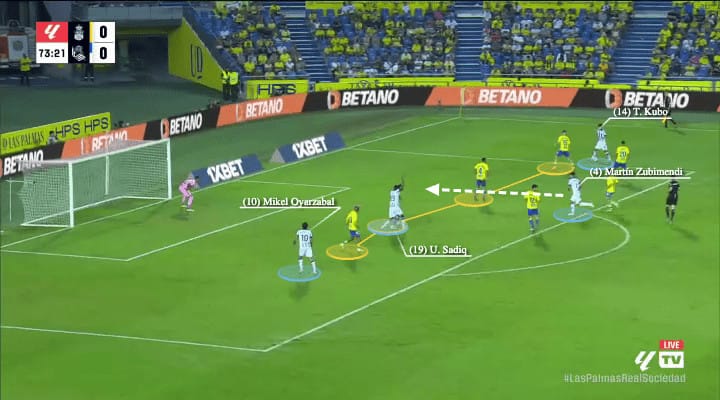
Again, another chance was created against Las Palmas, which was also attributed to Kubo’s dribbling and ball-carrying on the right side.
Furthermore, they added numbers in the penalty box with Zubimendi’s deep run.
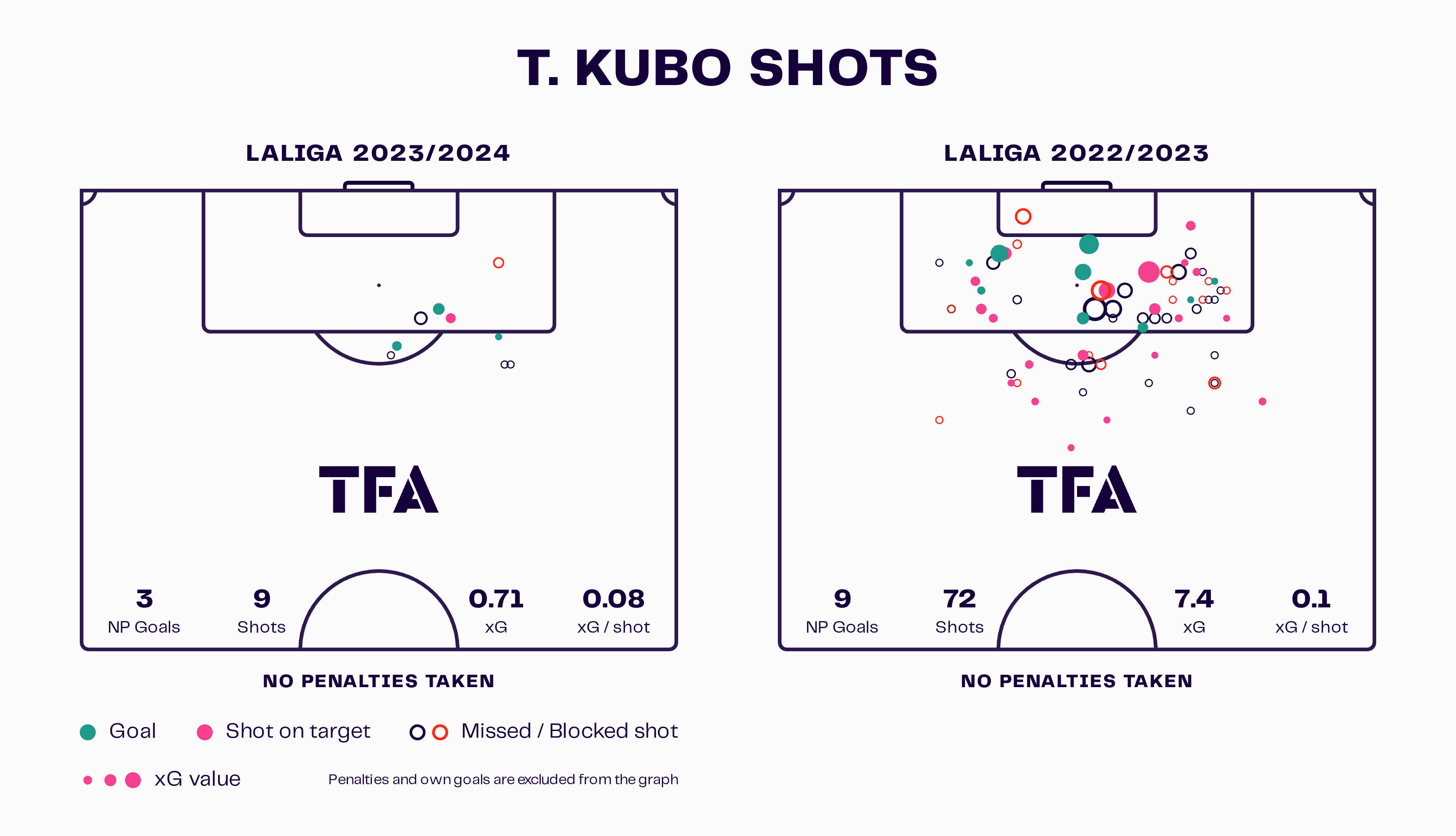
We can also observe the role change of Kubo through the shot maps.
Last season, he had shots from almost all angles and positions, also included goals on the left side of the box.
However, as he returned to the right flank this season, he showed a more apparent tendency to shoot on the right side, and the shots no longer appeared on the left side.
As we pointed out, Kubo was the leading player, but Barrenetxea has also shown noticeable improvements and gradually took a starting position on the left flank.
The 21-year-old was more capable of keeping the ball in 1v1 actions and finishing chances in the penalty box.
He already had three goals this season, including scoring against Real Madrid away from home.
X-factor in the team
In addition to all the new arrivals, Sociedad also had Umar Sadiq added back into the squad.
The 26-year-old Nigerian striker was a €20m signing from UD Almería in 2022 but missed a large part of last season due to a cruciate ligament rupture.
At the time of writing, he had not started any game this season for Sociedad, but we believe he could be a strong contender to make an impact on the team.

Despite being a tall striker with physical strengths, Sadiq is not a fixed target man who always stays centre and serves as a long ball target, fighting for aerial duels.
He can do that, but he can do more than that.
Instead, he is also pacey and good on the ball, which allows him to challenge defenders in open situations.
That’s why Alguacil likes to put him on the pitch in the last part of the game when there is more space to attack.
Sadiq has not scored yet this season, but he’s definitely impacted offensive situations and created opportunities for his teammates and himself.
In this example versus Granada, Merino tore a through ball, Sadiq was very mobile, and he ran into space behind the defence.
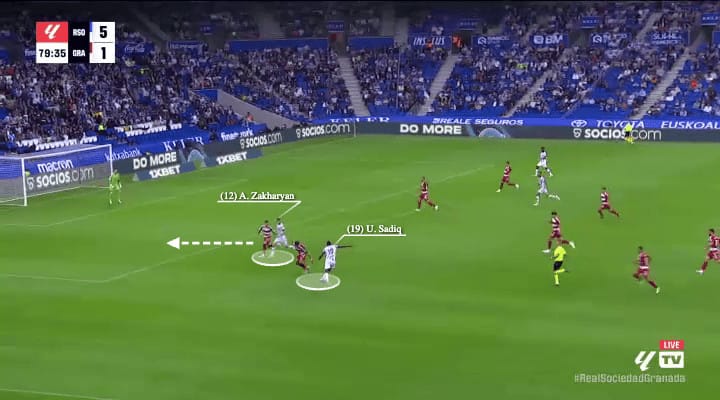
As he got near the penalty box, Zakharyan already made an early run behind and brought a defender away.
It became clear that Sadiq should take the space generated and carry it inside for a shot.
But in a raw situation, Sadiq could also take on opponents without the help of a teammate.
Here, he faced Carl Starfelt himself, and he just burst through the Swedish defender on the outside and then finished with a left-footed shot.
It was an excellent example to illustrate quality as compensation for the last instance versus Granada.
It shows Sadiq is a dynamic player who could go both sides, with or without teammates to help.
So far, Alguacil has tried Fernández and Oyarzabal in the striker position, but their skillsets were not similar to Sadiq’s.
If the Nigerian striker stays in good shape, he will add dynamics to the team and give the team more options or even more goals.
Before he joined Sociedad, he scored 18 goals in 36 games for UD Almería in La Liga 2.
Besides Sadiq, as we wrote in the scout report, Mohamed-Ali Cho is another very talented player in dribbling and taking on opponents.
He was signed from Angers last summer but suffered hamstring and ankle injuries last season.
He is another talent the club could develop and count on heavily in the future.
Conclusion
Although Real Sociedad are not quite there regarding results this season, it is understandable as the team has been in a transition period to allow all the new players to fit in.
As we have explained in this analysis, Alguacil was aware of the change of personnel and, therefore, dropped his successful 4-D-2 formation and changed it to a 4-1-2-3.
Sociedad have been scoring early goals and taking the leads but could not protect them with possession or defending.
If they could improve on managing the game flow, they could be back challenging the top four or even going for a cup trophy again.





Comments